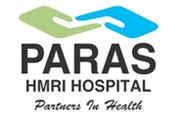Radiofrequency ablation (RFA) using 3D mapping is a complex procedure performed at very few centres in India
RFA involves removing dysfunctional heart tissue which is the cause of irregular heartbeats called arrhythmia using radio frequency heat
 Paras HMRI Hospital, Patna has added another feather to its cap by conducting a complex procedure to treat the condition of arrhythmia or irregular heart beat in a 70-year-old woman, joining a few elite centres across India which are capable of performing this procedure.
Paras HMRI Hospital, Patna has added another feather to its cap by conducting a complex procedure to treat the condition of arrhythmia or irregular heart beat in a 70-year-old woman, joining a few elite centres across India which are capable of performing this procedure.
Radio Frequency ablation using 3D mapping is a very complex procedure that requires high level of skill and experience on the part of cardiologists and cardiac electrophysiologists. The procedure is performed on patients having Atrial Fibrillation (AF), which is a difficult to treat heart rhythm disorder. Dr. Mithilesh Das, a renowned cardiologist from Indianapolis, US joined the team of doctors from Paras HMRI Hospital, Patna to perform this procedure.
A normal heart beats 60-100 times per minute, but if it starts beating too slowly or too fast or if the heartbeat is irregular or premature, the condition is known as Arrhythmia. AF is the condition of irregular heartbeats characterized by palpitations, fluttering or a sense of quivering in the chest. Most sudden cardiac deaths (that happen suddenly within an hour of onset of symptoms) are caused because of abnormal heart rhythms called arrhythmias.
Atrial fibrillation is a type of arrhythmia or heart rhythm disorder in which the upper chambers of the heart (the atria) beat irregularly instead of beating effectively to move blood into the ventricles. This condition can lead to blood clots, stroke, heart failure and other heart-related complications. In fact, Atrial Fibrillation increases the risk of stroke by 4-5 times.
“Our heart muscle beats to supply blood to all organs of the body. The heart’s electrical impulses generate power to enable the heart to beat. In some people a fault occurs in the heart’s electrical impulse generation system, and this is the cause of arrhythmia. The result is irregular heart beat. The condition is treated with the help of implantation of pacemaker devices or through burning/disabling the points from where irregular beats originate, depending upon the type of arrhythmia. Using radiofrequency heat waves, we disable the tissue that is the source of faulty electrical impulses,†says Dr Mithilesh Kumar Das.
Dr Das is Associate Professor of Clinical Medicine at Krannert Institute of Cardiology and Chief of Cardiac Electrophysiology at Roudebush VA Medical Center, Indiana University School of Medicine, Indianapolis.
Radiofrequency ablation (RFA) uses heat generated from medium frequency alternating current (in the range of 350–500 kHz) to disable or remove the dysfunctional tissue of the heart. But before that an electrical 3D mapping of the heart is done to diagnose the origins of arrhythmias.
“Having performed this procedure successfully, we at Paras HMRI Hospital have achieved a unique milestone in the management of heart disorders. Radio Frequency ablation using 3D mapping is a difficult procedure, and very few centres in India have the technological and medical capability of performing it. Acquiring this capability will help our cardiology team to help a large number of patients of arrhythmia,†adds Dr Pramod Kumar, Director, Cardiologyat Paras HMRI Hospital, Patna.
The procedure was performed in four hours. Having undergone the procedure, the patient is now healthy and has normal heart rhythm.


